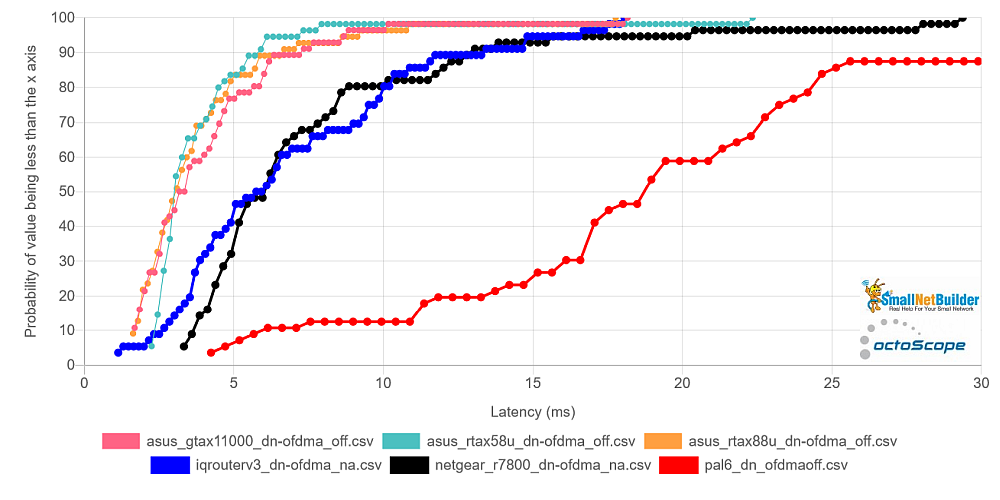No, not really. I'm saying the conditions where MU-MIMO can provide a measurable, significant benefit are so few that it is essentially useless.So in other words it's something that will benefit users sometimes in the future when nearly every device supports it basically, which would be like 5 - 10 years down the road.
You are using an out of date browser. It may not display this or other websites correctly.
You should upgrade or use an alternative browser.
You should upgrade or use an alternative browser.
Vexira
Part of the Furniture
That's extremely disappointing in that case.No, not really. I'm saying the conditions where MU-MIMO can provide a measurable, significant benefit are so few that it is essentially useless.
same goes for OFDMA ?No, not really. I'm saying the conditions where MU-MIMO can provide a measurable, significant benefit are so few that it is essentially useless.
thx
same goes for OFDMA ?
thx

Does OFDMA Really Work? Part 2 - SmallNetBuilder
Our test of six Wi-Fi 6 routers found no significant benefit from OFDMA.
 www.smallnetbuilder.com
www.smallnetbuilder.com
Tech Focus
Regular Contributor
First off, no Apple devices support MU-MIMO.
I didn’t even know apple devices did not support MU-MIMO.
@thiggins
Yes. It makes sense especially if my home ecosystem is not supporting. I think 3D TV analogy makes perfect sense.
@Vexira
Tech is my hobby so by then I’d be on board with the latest and greatest Wifi 8!
Keith Gorham
Regular Contributor
Tech is my hobby so by then I’d be on board with the latest and greatest Wifi 8!
I hear WiFi 9 will really solve all the issues.
Vexira
Part of the Furniture
I want wifi 13 with bi direction signal, 8 streams per channel mu Mimo V3 it will be perfect.
Klueless
Very Senior Member
I agree.Most likely never. Wifi is a shared medium (unlike Ethernet where you have two separate transmit and receive wires). You can't have two signals sent at the same time over the same frequency. The only way would be to split the frequency band in two, leaving you with only half of the bandwidth in either directions.
Ethernet also started off as a single cable half duplex shared medium and it took many years to evolve to full duplex. Simply adding the 2nd wire didn't do it as they were still collected at hubs, Layer 1, multi-port repeaters, also half duplex by definition. It wasn't until the advent of switches, multi-multi port bridges at Layer 2 that full duplex became a possibility.
So start with a dual-band (two radios) AP, one for send and the other for receive, and you have "full duplex". But to add another user you need two more radios? Uh, that's not going to scale well.
So instead of using a channel width of 160 you might try 8 channels with a width of 20 each? That's 8 channels, 4 up and 4 down ... four users total. So not only do we have a limited number of users we also have everyone running slower. MU-MIMO? Even if/when MU-MIMO works we run into similar scalability issues.
So, at least for the immediate future, better to go fast and find better ways to share. I'm thinking things like "Airtime Fairness" or 1x1 MU-MIMO clients connecting to 4x4 MU-MIMO services?
EDIT: It occurs to me, while Full Duplex may be nice, how important is it ... really? Many, me anyway, are "leeches", bidirectional communications are minimal. We download; Movies, books, TV shows, news. Up communications are typically "ACKs"; "ok, thanks, send me more". Our attention is probably better directed to multiple WiFi users all living in the same collision domain.
Last edited:
chadster766
Very Senior Member
OFDMA does split the channels as mentioned but if a device only require 1 channel it should only get one and the rest are available.
sfx2000
Part of the Furniture
Most likely never. Wifi is a shared medium (unlike Ethernet where you have two separate transmit and receive wires). You can't have two signals sent at the same time over the same frequency. The only way would be to split the frequency band in two, leaving you with only half of the bandwidth in either directions.
Indeed... that being said - WiFI has always been time divided and half-duplex.
Nothing wrong with that.
The big hit on 802.11 is that it has to be backwards compatible all the way back to 802.11b (in 2.4GHz) and 11a in 5GHz.
Klueless
Very Senior Member
Good point. Now when I check the "N Only" box under 2.4 GHz do I eliminate that liability? If so when will we see a similar feature under 5 GHz (to eliminate backward compatibility for A)?The big hit on 802.11 is that it has to be backwards compatible all the way back to 802.11b (in 2.4GHz) and 11a in 5GHz
sfx2000
Part of the Furniture
Good point. Now when I check the "N Only" box under 2.4 GHz do I eliminate that liability? If so when will we see a similar feature under 5 GHz (to eliminate backward compatibility for A)?
11a is not nearly as bad - coexists nicely with 11n,11ac
Klueless
Very Senior Member
Well that is good news but how does that work? Wouldn't, for example, beacons have to be sent at a mere 10 Mbps to be backwards compatible?11a is not nearly as bad - coexists nicely with 11n,11ac
sfx2000
Part of the Furniture
Well that is good news but how does that work? Wouldn't, for example, beacons have to be sent at a mere 10 Mbps to be backwards compatible?
There's valid reasons to send the beacons at 10 Mbps - it's used for channel estimation on the radio link...
6E has different classes of channels, "indoor" and "indoor-outdoor". Only equipment using indoor-outdoor channels have to check the AFC database.I heard 6GHz spectrum will only support 80+ MHz channels and will need to phone into a local database for use. Anybody heard this?
6E doesn't mandate use of 80/160MHz channels. But lower Tx power limits will move people toward 80MHz channels, which are the norm for consumer AC/AC Wi-Fi anyway.
This SniffWiFi post has a very good summary of 6E's requirements.
Last edited:
Like how current tri-band routers tend to have the first radio handle UNII-1 channels, and the second one handle UNII-3 channels.
I know this post is from April but just wanted to point out I was furious when I discovered this.
My dual band RT-N66U could handle channels 36-64 and 100-140.
But the ZenWifi XT8'S split this into two bands.
The backhaul was restricted to 100-140 meaning I could never achieve 160mhz because of a local weather radar. When 36-64 would have been fine for 160mhz.
This just smacked of marketing over functionality to me so I returned it and will wait for ZenWifi 6e.
I still have your FW on my RT-N66U BTW, even though its not supported it runs great
Enthusiast
Occasional Visitor
I know this post is from April but just wanted to point out I was furious when I discovered this.
My dual band RT-N66U could handle channels 36-64 and 100-140.
But the ZenWifi XT8'S split this into two bands.
The backhaul was restricted to 100-140 meaning I could never achieve 160mhz because of a local weather radar. When 36-64 would have been fine for 160mhz.
This just smacked of marketing over functionality to me so I returned it and will wait for ZenWifi 6e.
I still have your FW on my RT-N66U BTW, even though its not supported it runs great
DFS spectrum is restricted by radars, that's normal. You will have to wait for a long time to get wifi6e.
DFS spectrum is restricted by radars, that normal. You will have to wait for a long time to get wifi6e.
I understand DFS.
What I was getting at was marketing beating functionality.
If I could put the backhaul on the other channels then DFS wouldn't be an issue.
But "Tri-band" sounds better than useless.
6e will be here by end of year if not next year. So not too long to wait. I'd expect to see the XT8 6e before 3rd quarter next year.
Similar threads
- Replies
- 12
- Views
- 2K
- Replies
- 4
- Views
- 785
- Replies
- 0
- Views
- 389
- Replies
- 2
- Views
- 1K
Latest threads
-
Can Guest Network Pro (guest network #1) use a DNS server which is located in the main LAN?
- Started by Rici
- Replies: 1
-
YazFi guest networks stop working when changing DNS or using VPN
- Started by jsn2233
- Replies: 1
-
-
This is sooooooo frustrating!! Does anyone have any idea ?!
- Started by pfunk25
- Replies: 4
Support SNBForums w/ Amazon
If you'd like to support SNBForums, just use this link and buy anything on Amazon. Thanks!
Sign Up For SNBForums Daily Digest
Get an update of what's new every day delivered to your mailbox. Sign up here!
Members online
Total: 1,639 (members: 14, guests: 1,625)

